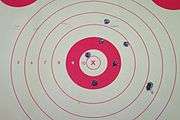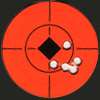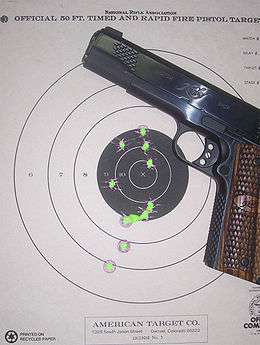Shooting target


Shooting targets are objects in various forms and shapes that are used for pistol, rifle, shotgun and other shooting sports, as well as in darts, target archery, crossbow shooting and other non-firearm related sports. The center is often called the bullseye. Targets can for instance be made of paper, "self healing" rubber or steel. There are also electronic targets that electronically can provide the shooter with precise feedback of the shot placement.
History
Most targets used in shooting sports today are abstract figures of which origins often are not given much thought, but given the military and hunting origins that started most shooting disciplines it is not hard to understand that many of the targets at some point originally resembled either human opponents in a battle or animals in a hunting situation. For instance, the well known circular bullseye target might originally have resembled a human torso or an animal being hunted. Notable instances of shooting targets with martial origins which are considered abstract today, are the field targets used in Det frivillige Skyttervesen where the original intent was to resemble amongst other wheels of vehicles (S25 target), barrels (tønne), bunker openings (stripe 30/10 and 13/40) or enemy personnel (1/3, 1/4, 1/6 and 1/10 figure, minismåen, etc.). The origin of these targets are not usually given much attention (or is even known by most shooters), and have been kept around for variation and tradition.
Types of targets
Some types of targets are:
- Steel targets
- Paper or cardboard
- Frangible (such as clay or tiles)
- Self healing rubber target
Reactive
Reactive targets are designed to move and/or bounce along the ground when hit.
 A Cabela's branded "Self healing ground bouncing reactive" target
A Cabela's branded "Self healing ground bouncing reactive" target
Explosive
Targets are designed to explode when stuck with a bullet traveling at a suitable velocity to induce detonation.
 Exploding target detonation
Exploding target detonation Exploding target detonation
Exploding target detonation
Air rifle field targets
In the outdoor air gun discipline field target metal targets of various shape and forms are used. The metal plates are often shaped to resemble small game animals, although there is currently a move towards simple geometric shapes.
 A crow-shaped, knock-over metal air gun field target. The black painted metal paddle must be hit to make the target fall over, and the target can be reset by pulling the orange cord attached to the face-plate.
A crow-shaped, knock-over metal air gun field target. The black painted metal paddle must be hit to make the target fall over, and the target can be reset by pulling the orange cord attached to the face-plate. Another crow-shaped, knock-over metal air gun field target. The black painted metal paddle must be hit to make the target fall over, and the target can be reset by pulling the orange cord attached to the face-plate
Another crow-shaped, knock-over metal air gun field target. The black painted metal paddle must be hit to make the target fall over, and the target can be reset by pulling the orange cord attached to the face-plate A rat knock-over metal air gun field target.
A rat knock-over metal air gun field target.
Archery
- Archery trap machine with an arrow in the disc
.jpg) Robert Edward Dillon and his sister Georgiana, practising archery in the grounds of Clonbrock House, Co. Galway. In the manner of younger brothers throughout history, he seems to be claiming credit for the winning shot...Date: Circa 1883
Robert Edward Dillon and his sister Georgiana, practising archery in the grounds of Clonbrock House, Co. Galway. In the manner of younger brothers throughout history, he seems to be claiming credit for the winning shot...Date: Circa 1883.jpg) Time to score, collecting arrows and scoring at Dunster Archery competition, Somerset, 2009.
Time to score, collecting arrows and scoring at Dunster Archery competition, Somerset, 2009..jpg)
.jpg)

FITA targets
FITA targets are used in archery shooting competitions within the World Archery Federation. The targets have 10 evenly spaced concentric rings, generally with score values from 1 through 10. In addition there is an inner 10 ring, sometimes called the X ring. This becomes the 10 ring at indoor compound competitions, while outdoors, it serves as a tiebreaker with the archer scoring the most X's winning. The number of hits may also be taken into account as another tiebreaker. In FITA archery, targets are coloured as follows:
- 1 & 2 ring: White
- 3 & 4 ring: Black
- 5 & 6 ring: Blue
- 7 & 8 ring: Red
- 9, 10 & inner 10 (X) ring: Gold
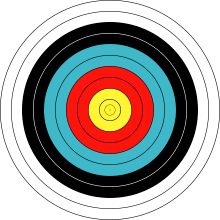 The FITA target is used in target archery by the World Archery Federation.
The FITA target is used in target archery by the World Archery Federation.
3D archery targets
3D targets are life-size models of game used in field archery.
 A coyote "3D target".
A coyote "3D target".
Clay pigeons
Clay pigeon targets are usually used as flying targets for clay pigeon shooting, formally known as Inanimate Bird Shooting.
 A 10 cm (4 inch) clay pigeon.
A 10 cm (4 inch) clay pigeon. Clay pigeon throwing machine.
Clay pigeon throwing machine.
Popinjays
The Popinjay (from the French papegai, or "parrot") is an ancient form of target for crossbow shooting. Originally a bird tethered in a tree, it developed into a complex painted wood target atop a tall wooden pole. The popinjay would form the centrepiece of a major shooting contest and many shooters would try their skill repeatedly against the same target. Scoring was awarded for shooting off various parts of the target.
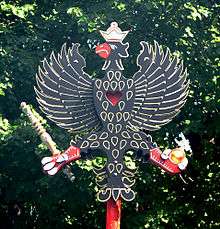 A Popinjay target used for Adler shooting during the 2010 Rutenfest Ravensburg festival in Germany
A Popinjay target used for Adler shooting during the 2010 Rutenfest Ravensburg festival in Germany
Dart
Dart targets are a special form of bullseye targets.
 Darts in a bullseye target
Darts in a bullseye target



Human silhouette
Human silhouette targets are use for military, police and civilian firearms training.
- NATO E-type Silhouette Target
 Human silhouette target
Human silhouette target- A digital target range at the firearms training simulator on Kunsan Air Base waits to be used.
 Swiss military targets
Swiss military targets_140403-M-MX805-097_(13659746275).jpg)


_2_Swift_fires_an_M9_during_weapons_qualification_on_the_fantail.jpg)
.jpg)

International Shooting Sport Federation
Within the International Shooting Sport Federation mostly various bullseye targets are used, with variances depending on disciplines. For shotgun clay targets are used.
 |
 |
 |
 | |||||
|---|---|---|---|---|---|---|---|---|
| 25 m Rapid Fire Pistol | 25 m Precision Pistol | 50 Meter Pistol | 10 Meter Air Pistol | |||||
| Subtension | Angular size | Subtension | Angular size | Subtension | Angular size | Subtension | Angular size | |
| Inner Ten | 50 mm | 2 mil | 25 mm | 1 mil | 25 mm | 0.5 mil | 5 mm | 0.5 mil |
| 10 Ring | 100 mm | 4 mil | 50 mm | 2 mil | 50 mm | 1 mil | 11.5 mm | 1.15 mil |
| Subsequent Ring Increase |
80 mm | 3.2 mil | 50 mm | 2 mil | 50 mm | 1 mil | 16 mm | 1.6 mil |
| (image missing) |  | |||
|---|---|---|---|---|
| 50 m Running Target (Rifle) | 10 m Running Target (Rifle) | |||
| Subtension | Angular size | Subtension | Angular size | |
| Inner Ten | 30 mm | 0.6 mil | 0.5 mm | 0.05 mil |
| 10 Ring | 60 mm | 1.2 mil | 5.5 mm | 0.55 mil |
| Subsequent Ring Increase |
34 mm | 0.68 mil | 5 mm | 0.5 mil |
 |
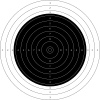 |
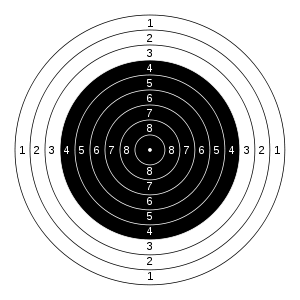 | ||||
|---|---|---|---|---|---|---|
| 300 m Rifle | 50 m Rifle | 10 m Air Rifle | ||||
| Subtension | Angular size | Subtension | Angular size | Subtension | Angular size | |
| Inner Ten | 50 mm | 1/6 mil ≈ 0.167 mil | 5 mm | 0.1 mil | (Determined by scoring gauge) | - |
| 10 Ring | 100 mm | 1/3 mil ≈ 0.33 mil | 10.4 mm | 0.208 mil | 0.5 mm | 0.05 mil |
| Subsequent Ring Increase |
100 mm | 1/3 mil ≈ 0.33 mil | 16 mm | 0.32 mil | 5 mm | 0.5 mil |
International Practical Shooting Confederation
In matches organized by the International Practical Shooting Confederation, both steel and paper targets are used. Currently the only paper targets used for handgun is the IPSC Target (formerly Classic Target) and the 2/3 scaled down IPSC Mini Target (formerly IPSC Mini Classic Target). Additionally, for rifle and shotgun "A3" and "A4" paper targets and the "Universal Target" is used. For steel targets, standardized knock down targets called "poppers" are used. The two approved designs are the full size "IPSC Popper" (formerly IPSC Classic Popper) and the 2/3 scaled down version "IPSC Mini Popper" (formerly "IPSC Classic Mini Popper"), while the Pepper Popper and Mini Pepper Popper is now obsolete.
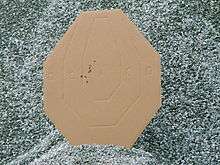 The octagonal IPSC Target (formerly known as the Classic Target) is a cardboard target used in all disciplines within the International Practical Shooting Confederation.
The octagonal IPSC Target (formerly known as the Classic Target) is a cardboard target used in all disciplines within the International Practical Shooting Confederation. The full size IPSC Popper (formerly known as the Classic Popper).
The full size IPSC Popper (formerly known as the Classic Popper). IPSC Mini Popper (formerly known as Classic Mini Popper), a 2/3 scaled down version of the IPSC Popper used to simulate greater distance.
IPSC Mini Popper (formerly known as Classic Mini Popper), a 2/3 scaled down version of the IPSC Popper used to simulate greater distance. Pepper Popper, no longer used in IPSC competitions.
Pepper Popper, no longer used in IPSC competitions. Mini Pepper Popper, no longer used in IPSC competitions.
Mini Pepper Popper, no longer used in IPSC competitions.
Metallic silhouette
In metallic silhouette shooting only knock down steel targets featuring animals are used.
 Metallic silhouette targets featuring a chicken, pig, turkey and ram, scaled to appear as they would if placed at the correct distances from the shooter. Scale in minutes of angle, correct for NRA high power rifle using yards.
Metallic silhouette targets featuring a chicken, pig, turkey and ram, scaled to appear as they would if placed at the correct distances from the shooter. Scale in minutes of angle, correct for NRA high power rifle using yards..jpg) A Hunter Field Target (HFT) metallic target in the form of a Rat.
A Hunter Field Target (HFT) metallic target in the form of a Rat.
Plinking
Plinking refers to casual shooting practices aiming at informal target objects such as tin cans, glass bottles, steel barrels/plates, or anything else that draws the shooter's attention.
 Drum
Drum
